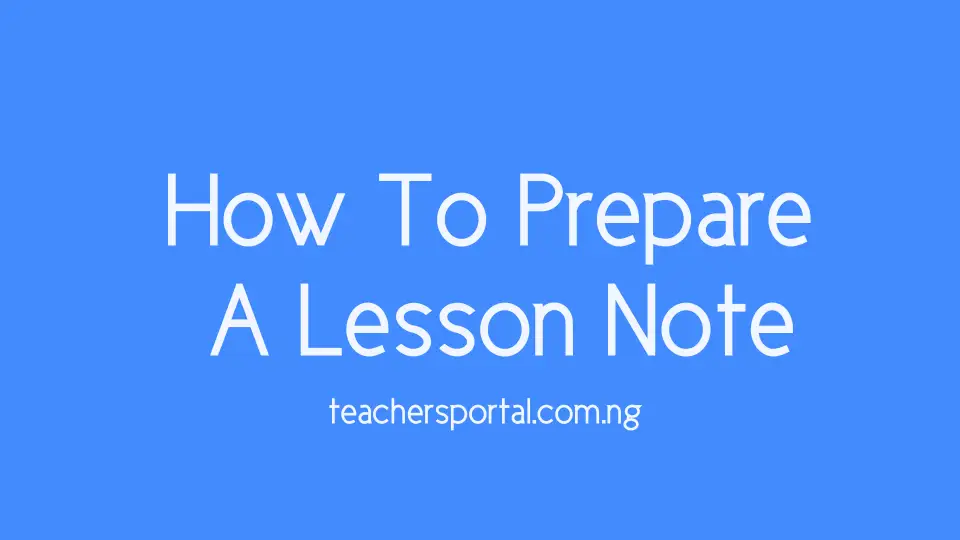Lesson notes play a pivotal role in effective teaching, serving as a roadmap for educators to guide their classroom instruction. With a well-prepared lesson note, teachers can bring organization, structure, and engagement into their teaching, creating a conducive environment for enhanced learning outcomes. In this article, we will delve into how to prepare lesson notes that impact the teaching and learning process.
What is a Lesson Note
A lesson note is a detailed record of the lesson’s content created by the teacher and shared with students to aid in internalization, revision, and further study. It encompasses the teacher’s information as well as the notes taken by students during the lesson, serving as valuable resources for reinforcing understanding and supporting independent learning.
A lesson note is a written document that encompasses essential information and guidelines for both teachers and students regarding the delivery and execution of a specific lesson. It serves as a reference tool, providing teachers with the necessary details, curriculum content, and additional information required to effectively impart knowledge to students. Unlike a lesson plan, which is the property of the school and requires approval before implementation, a lesson note primarily belongs to the individual teacher and is considered their personal equipment for teaching.
The lesson note includes comprehensive information that aids the teacher in delivering the lesson, such as the lesson objectives, teaching methods, instructional materials, assessment strategies, and any other relevant details. It serves as a blueprint for the teacher’s instructional approach, ensuring that the desired learning outcomes are achieved.
While a school may interfere with the lesson plan to ensure compliance with policies, ethics, and standards, such interference is not typically expected for lesson notes. The school’s primary interest lies in the lesson plan, which is subject to their approval. In some cases, schools may choose to develop the lesson plan themselves through designated authorities and subsequently provide it to the teacher.
A teacher’s lesson note does not always have to be comprehensive, meaning it does not need to contain every single detail about the lesson. Instead, the focus of a lesson note is on its substance and the essential elements that bring a lesson plan to life.
While a lesson plan outlines the overall structure, goals, and activities of a lesson, a lesson note serves as a tool for the teacher to translate those plans into action. It is within the lesson note that the substance of the lesson plan is fleshed out and implemented in a practical manner.
The lesson note goes beyond the broad outline of the lesson plan and provides the teacher with specific guidance on how to execute the lesson effectively. It includes details such as teaching strategies, specific instructions, relevant examples, learning materials, and any additional information that the teacher deems necessary to facilitate learning.
How To Prepare A Lesson Note
Preparing a lesson note involves organizing and structuring the content you plan to teach in a clear and effective manner. Here are some steps to help you prepare a lesson note:
1. Determine the learning objectives: Start by identifying what you want your students to learn or achieve by the end of the lesson. Clearly define the specific learning outcomes you expect from the students.
2. Choose a lesson topic: Select a topic that aligns with the curriculum and the learning objectives. Ensure that it is relevant and engaging for your students.
3. Gather the necessary materials: Collect all the materials, resources, and tools you will need for the lesson. This may include textbooks, worksheets, multimedia presentations, or any other materials that will support your teaching.
4. Outline the lesson structure: Create a framework for your lesson. Divide it into different sections, such as introduction, main content, activities, and conclusion. This will help you maintain a logical flow throughout the lesson.
5. Introduction: Begin the lesson with an engaging introduction to capture the students’ attention and provide an overview of what they will be learning. You can use a hook, ask questions, or share a relevant story or example.
6. Present the main content: This is the core of your lesson. Break down the content into smaller, manageable chunks. Use different teaching strategies and techniques, such as lectures, discussions, demonstrations, visuals, or hands-on activities, to present the information effectively.
7. Plan activities and exercises: Include various activities, exercises, and discussions to actively involve the students in the learning process. These can be individual, group, or class-wide activities that reinforce the concepts taught and allow students to practice and apply their knowledge.
8. Provide clear instructions: Clearly explain the instructions for each activity or exercise. Specify the expected outcomes and any materials or resources required. Anticipate potential difficulties or questions students may have and address them in your instructions.
9. Assessment and evaluation: Determine how you will assess students’ understanding and learning progress. Include formative assessments throughout the lesson to check for understanding. You can use quizzes, discussions, group work, or other methods to evaluate their learning.
10. Conclusion and review: Summarize the main points covered in the lesson and reinforce the key concepts. Allow time for questions and clarification. Provide a brief overview of the next lesson or homework assignments, if applicable.
11. Reflection and revision: After teaching the lesson, take some time to reflect on its effectiveness. Consider what worked well and what could be improved. Use this feedback to revise and refine your lesson plan for future use.
Remember, a lesson note is a guide for yourself, so make sure it is clear and organized. It should help you deliver the lesson effectively and ensure that you cover all the necessary content while engaging your students in the learning process.
